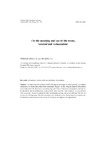Mostrar o rexistro simple do ítem
On the meaning and use of the terms, ‘erosion’and ‘exhumation’
| dc.contributor.author | Twidale, C. R. | |
| dc.contributor.author | Bourne, J. A. | |
| dc.date.accessioned | 2019-02-21T08:30:35Z | |
| dc.date.available | 2019-02-21T08:30:35Z | |
| dc.date.issued | 2017 | |
| dc.identifier.citation | Cadernos do Laboratorio Xeolóxico de Laxe: Revista de xeoloxía galega e do hercínico peninsular, ISSN 0213-4497, Nº 39, 2017, páxs. 165-176 | es_ES |
| dc.identifier.issn | 0213-4497 | |
| dc.identifier.uri | http://hdl.handle.net/2183/21899 | |
| dc.description.abstract | [Abstract] It is important that technical terms with agreed meanings are used correctly. This applies particularly to words that reflect their etymology. Neglect of this principle distorts information and compromises the discussion, understanding, and value of otherwise useful papers and reports. In discussion and in publications, some authors have used the term ‘exhumed’ as synonymous with ‘erosional’, whereas in disciplines like stratigraphic geology and geomorphology the two are perceived as having quite different meanings and implications for chronological reconstructions. Furthermore, some aspects of the nature of erosion do not appear to be appreciated | es_ES |
| dc.language.iso | spa | es_ES |
| dc.subject | Exhumation | es_ES |
| dc.subject | Erosion | es_ES |
| dc.subject | Etch | es_ES |
| dc.subject | Unconformity | es_ES |
| dc.subject | Discontinuity | es_ES |
| dc.title | On the meaning and use of the terms, ‘erosion’and ‘exhumation’ | es_ES |
| dc.type | info:eu-repo/semantics/article | es_ES |
| dc.rights.access | info:eu-repo/semantics/openAccess | es_ES |
| UDC.journalTitle | Cadernos do Laboratorio Xeolóxico de Laxe: Revista de xeoloxía galega e do hercínico peninsular | es_ES |
| UDC.volume | 39 | es_ES |
| UDC.startPage | 165 | es_ES |
| UDC.endPage | 176 | es_ES |






